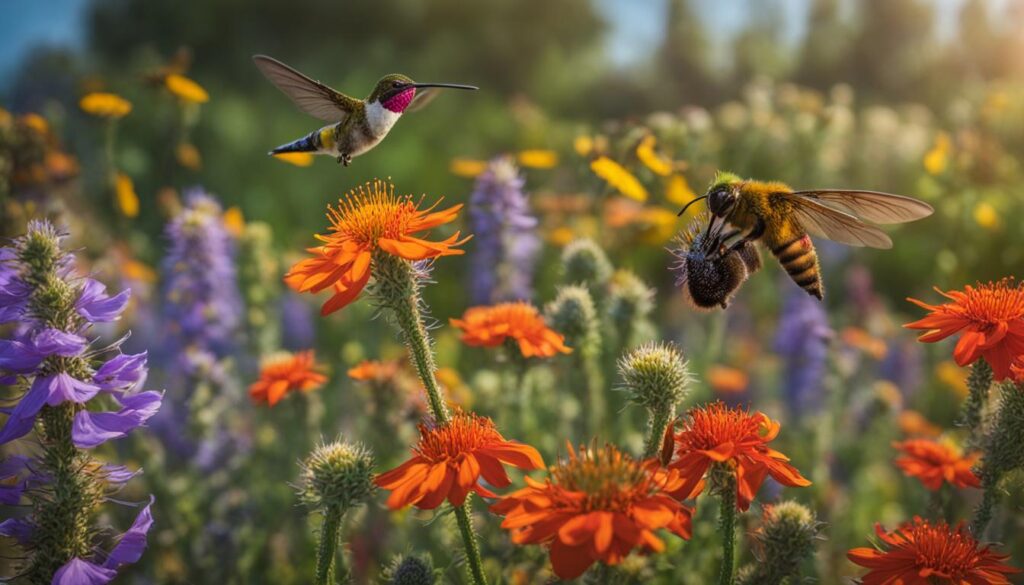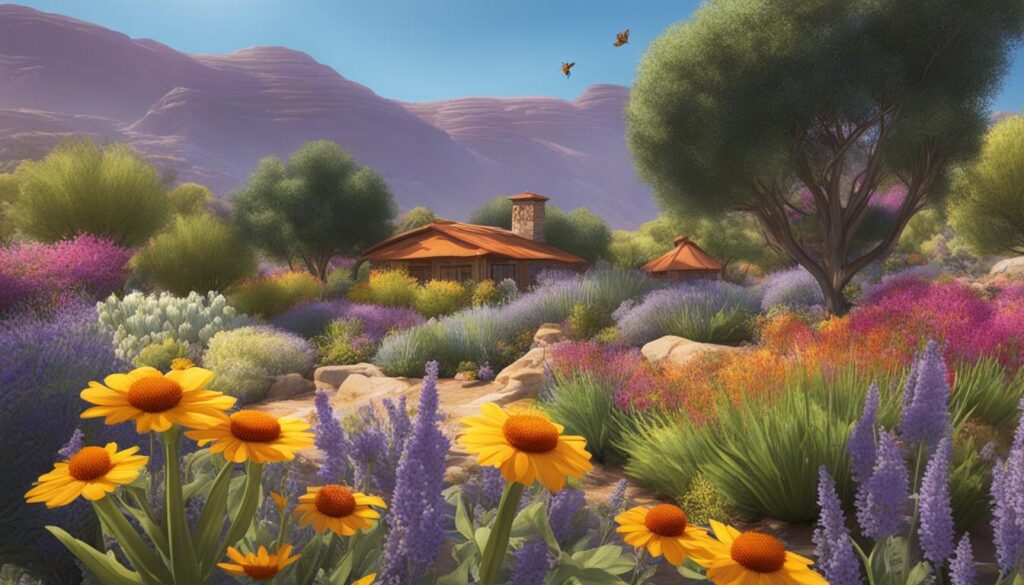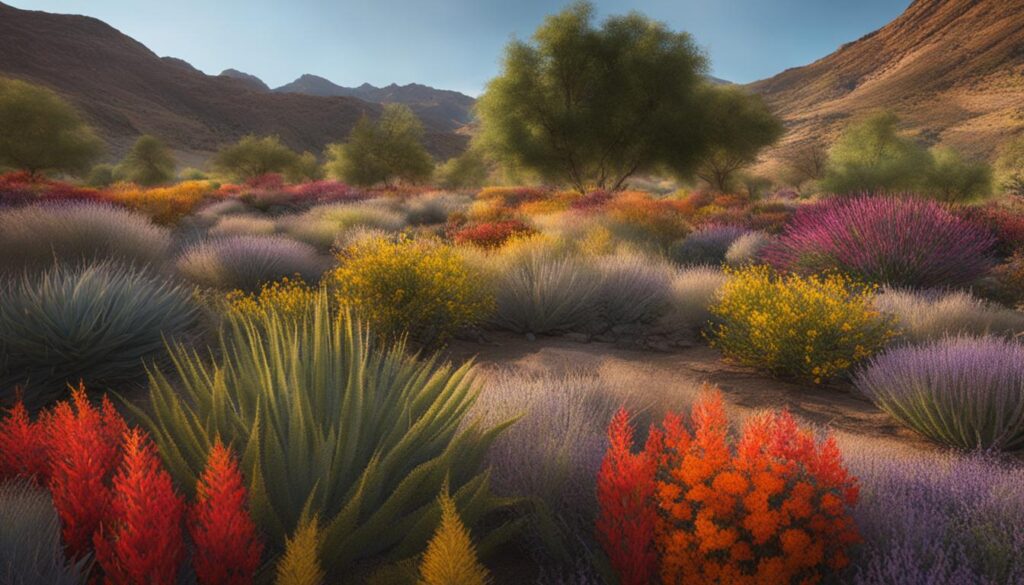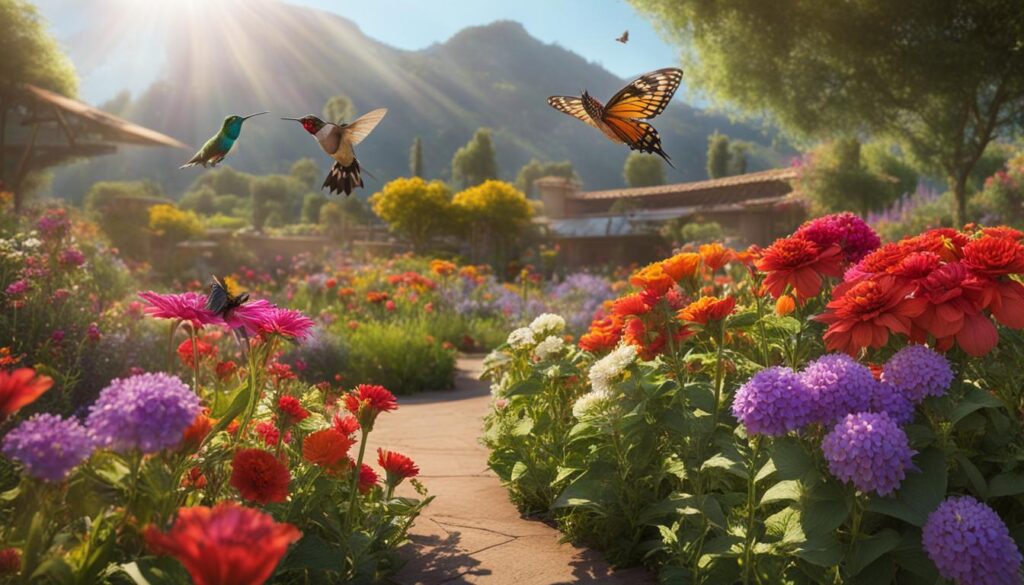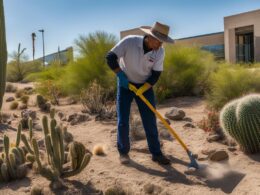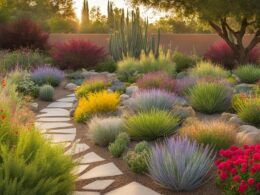Welcome to our guide on choosing drought-tolerant plants for pollinators. With concerns about water conservation and the well-being of our ecosystem, it’s essential to prioritize eco-friendly gardening practices. By selecting plants that require less water, you can create a beautiful and sustainable habitat for pollinators, such as bees and butterflies.
Key Takeaways
- Choosing drought-tolerant plants supports pollinators while conserving water.
- Creating a varied landscape with native plants attracts a wide variety of pollinators.
- Provide a water source for pollinators in your drought-tolerant garden.
- Avoid using insecticides that could harm pollinators.
- Consider the bloom time and flower shape of native plants to attract diverse pollinators.
Importance of Drought-Tolerant Plants for Pollinators
The importance of drought-tolerant plants for pollinators cannot be overstated. With the increasing challenges faced by pollinators, such as habitat loss and pesticide use, providing a sustainable and attractive habitat is crucial. Drought-tolerant plants offer a solution by being able to provide food and shelter for pollinators without the need for excessive water use. By selecting these plants, you can help support pollinators and contribute to the conservation of their populations.
Many pollinators, including bees, butterflies, and hummingbirds, rely on a steady supply of nectar and pollen for their survival. Drought-tolerant plants, with their ability to thrive in water-scarce conditions, can still produce vibrant flowers that attract and provide sustenance for these important species. By planting these flowers, you are not only creating a beautiful landscape but also supporting the delicate balance of our ecosystems.
Furthermore, drought-tolerant plants can contribute to the overall health and resilience of pollinator populations. By selecting plants that bloom at different times throughout the year, you can ensure a continuous supply of food for pollinators. This is especially important during periods when other food sources may be scarce. By offering a diverse range of flowering plants, you can attract a variety of pollinators, each with unique preferences for flower shape, color, and scent.
| Benefits of Drought-Tolerant Plants for Pollinators |
|---|
| Conserves water |
| Provides food and shelter for pollinators |
| Supports biodiversity |
| Attracts a variety of pollinators |
| Contributes to the health of ecosystems |
Choosing drought-tolerant plants for pollinators is not just about conserving water. It’s about creating a sustainable and vibrant habitat that supports the intricate web of life that relies on pollination. By selecting these plants, you are making a positive impact on the survival of pollinators and the health of our ecosystems.
Conserving Water and Supporting Pollinators
One of the key benefits of drought-tolerant plants is their ability to conserve water. By reducing the need for excessive watering, you can help support pollinators while also practicing eco-friendly gardening. This is especially important in regions that experience regular drought conditions or have limited access to water resources.
Moreover, by choosing drought-tolerant plants, you can inspire others in your community to adopt similar practices. This ripple effect can contribute to a larger-scale conservation effort, helping to protect and sustain pollinators in the long run. Remember, every small action counts, and by selecting drought-tolerant plants, you are taking a step towards a more sustainable future for pollinators and our environment.
Choosing Native Drought-Tolerant Plants
When creating a drought-tolerant garden to support pollinators, selecting native plants is an excellent choice. Native plants are well adapted to the local soil and weather conditions, making them resilient and low maintenance. They also play a crucial role in supporting local pollinator populations. Native flora provides familiar food sources and habitat for wild pollinators, ensuring they have the resources they need to thrive.
When choosing native drought-tolerant plants, consider factors such as bloom time and flower shape to attract a diverse range of pollinators. Aim for a variety of plants that bloom at different times of the year to provide a consistent supply of nectar and pollen. Different pollinators have preferences for specific flower shapes, so including a mix of flower types will help attract a wider range of species. Additionally, leaving patches of bare soil and incorporating items like logs into your garden provides nesting opportunities for solitary bees and other beneficial insects.
Native drought-tolerant plants can be found at local nurseries and garden centers that specialize in native flora. These establishments often have knowledgeable staff who can provide guidance on selecting the right plants for your specific region. Online resources, such as websites that offer a nursery locator tool, can also help you find native plant suppliers in your area. Before making a purchase, it’s essential to research and choose nurseries that offer native plants suitable for your region. Supporting local nurseries and growers promotes the use of native plants and contributes to the preservation of regional biodiversity.
| Native Drought-Tolerant Plants | Scientific Name | Bloom Time |
|---|---|---|
| Lavender | Lavandula | Summer |
| Sage | Salvia | Spring, Summer, Fall |
| Coneflower | Echinacea | Summer, Fall |
| Sunflower | Helianthus | Summer, Fall |
| Redbud | Cercis | Spring |
| Catnip | Nepeta | Summer |
| Penstemon | Pentagonia | Spring, Summer |
| Lamb’s Ears | Stachys | Summer |
| Verbena | Verbena | Spring, Summer, Fall |
Table: Native Drought-Tolerant Plants for Pollinators
By choosing native drought-tolerant plants, you can create a beautiful and sustainable garden that supports pollinators and conserves water. These plants provide essential resources for pollinators, such as nectar and pollen, while also enhancing the overall health and biodiversity of your garden ecosystem.
Recommended Drought-Tolerant Plants for Pollinators
When it comes to creating a pollinator-friendly garden, selecting the right plants is paramount. Drought-tolerant plants not only conserve water but also provide essential food and shelter for pollinators. Here are some recommended plants that are beneficial for both pollinators and your garden:
| Plant | Scientific Name |
|---|---|
| Lavender | Lavandula |
| Sage | Salvia |
| Coneflower | Echinacea |
| Sunflower | Helianthus |
| Redbud | Cercis |
| Catnip | Nepeta |
| Penstemon | Penstemon |
| Lamb’s Ears | Stachys |
| Verbena | Verbena |
| Bells | Campanula |
| Aster | Aster |
| Black-eyed Susan | Rudbeckia |
| Oregano | Origanum |
| Yarrow | Achillea |
These plants offer a variety of colors, shapes, and bloom times, attracting a diverse range of pollinators to your garden. You can easily find these plants in nurseries and garden centers, ensuring accessibility for all garden enthusiasts.
It is important to note that before planting any new species, you should check for invasive plants in your area. Invasive species can outcompete native plants and disrupt ecosystems. By prioritizing native and drought-tolerant plants, you can create a thriving garden while supporting pollinator populations.
Why Choose Drought-Tolerant Plants for Pollinators?
Choosing drought-tolerant plants is not only beneficial for your garden but also for pollinators. These plants require less water, reducing your water consumption while still providing attractive food sources for pollinators. By selecting drought-tolerant plants that are native to your region, you can ensure they are well adapted to local weather conditions and support the native pollinator species in your area.
Drought-tolerant plants also play a crucial role in maintaining the health of pollinator populations. Many pollinators are facing challenges due to habitat loss, disease, and pesticide use. By planting drought-tolerant flowers, you are creating a sustainable habitat that offers food and shelter without the need for excessive water usage.
Creating a Diverse Landscape
When selecting drought-tolerant plants for pollinators, aim for a diverse landscape. Including plants with different bloom times will ensure a continuous supply of flowers throughout the seasons, providing a reliable food source for pollinators year-round. Additionally, consider the shape and size of the flowers to attract a variety of pollinator species, as different pollinators have specific preferences.
By creating a diverse and drought-tolerant garden, you can support pollinators while enjoying a beautiful and environmentally friendly space. Remember to provide water sources, avoid using harmful insecticides, and continue learning about the needs and preferences of pollinators in your area.
Pollinator-Friendly Landscapes with Drought-Tolerant Plants
Creating pollinator-friendly landscapes is not only beneficial for pollinators but also a sustainable way to maintain your garden. By incorporating drought-tolerant plants into your landscape, you can provide a welcoming habitat for pollinators while conserving water. Here are some tips to help you create a pollinator-friendly garden:
Plant a Variety of Drought-Tolerant Flowers
To attract a diverse range of pollinators, plan your garden with a variety of drought-tolerant flowers. Choose flowers that bloom at different times of the year to ensure a continuous supply of nectar and pollen. Consider the preferences of different pollinators, such as their preferred flower shape and color, to create an inviting space for them. Large clusters of the same type of flower can make foraging easier for pollinators.
Provide a Water Source
Water is essential for the survival of pollinators, especially during dry periods. Provide a water source in your garden, such as a shallow dish or a birdbath with rocks for landing. Ensure the water source is shallow to prevent pollinators from drowning. Regularly refill the water source to maintain a constant supply of water.
Table:
| Plant | Flower Shape | Bloom Period | Attracts |
|---|---|---|---|
| Lavender | Spike | Summer | Bees, Butterflies |
| Sage | Spike | Summer | Bees, Hummingbirds |
| Coneflower | Daisy-like | Summer, Fall | Bees, Butterflies |
| Redbud | Round | Spring | Bees, Butterflies |
“Creating a pollinator-friendly garden not only benefits these important creatures but also adds beauty and diversity to your outdoor space.” – Garden Enthusiast
Avoid Harmful Insecticides
Avoid using insecticides in your garden, as they can harm pollinators. Instead, adopt organic pest control methods and encourage natural predators of garden pests. By maintaining a healthy and balanced ecosystem, you can reduce the need for chemical pesticides and protect pollinators.
By following these tips and incorporating drought-tolerant plants into your landscape, you can create a pollinator-friendly garden that supports the vital role of pollinators in our ecosystem.
Ecoregional Planting Guides for Pollinators
The Pollinator Partnership provides ecoregional planting guides specifically designed to support and attract pollinators in different regions of the United States. These guides are invaluable resources for individuals seeking to create pollinator-friendly habitats using drought-tolerant plants. By tailoring plant selections to the unique conditions of each ecoregion, these guides help maximize the success of attracting and sustaining diverse pollinator populations.
Each ecoregional planting guide offers comprehensive lists of native plants that are well-suited to the specific region’s climate, soil, and other environmental factors. By choosing native plants, you can ensure that you are providing familiar food and habitat sources for local pollinators. These plants are adapted to thrive in the ecoregion’s specific conditions, requiring less water and maintenance compared to introduced species.
The guides also provide information on the bloom periods of the recommended plants. This is crucial for maintaining a continuous supply of flowers throughout the seasons, ensuring a reliable food source for pollinators year-round. In addition to plant species recommendations, the guides offer helpful tips on creating diverse landscapes, incorporating native grasses, providing nesting materials, and managing invasive species.
| Ecoregion | Description | Download Link |
|---|---|---|
| Southeast | Includes parts of Alabama, Georgia, South Carolina, and Florida. | Download |
| Great Lakes | Includes parts of Michigan, Wisconsin, Minnesota, Ohio, and Indiana. | Download |
| Western Mountains, Valleys, & Coast | Includes parts of California, Nevada, Oregon, and Washington. | Download |
| Great Plains | Includes parts of North Dakota, South Dakota, Nebraska, and Kansas. | Download |
| Mid-Atlantic | Includes parts of Pennsylvania, Maryland, Delaware, and New Jersey. | Download |
These ecoregional planting guides can be downloaded as PDFs from the Pollinator Partnership website. They offer valuable information tailored to specific areas, including native plant nurseries, additional resources, and contact information for further assistance. By following these guides and utilizing the recommended drought-tolerant plants, you can make a significant impact in supporting pollinators and fostering a healthier ecosystem.
Importance of Supporting Pollinators
Supporting pollinators is vital for the health of our ecosystem. These small creatures, such as bees, butterflies, and hummingbirds, play a crucial role in pollinating flowers and crops, ensuring the reproduction and survival of many plant species. By choosing drought-tolerant plants, we can create a sustainable environment that not only conserves water but also provides food and shelter for pollinators.
Drought-tolerant plants are an essential resource for pollinators, especially in regions prone to water scarcity. These plants have adapted to survive in arid conditions, requiring less water to thrive. By incorporating them into our gardens and landscapes, we can create habitats that support pollinators even during times of drought.
By supporting pollinators, we contribute to the overall health of our ecosystem. Pollinators help maintain biodiversity by facilitating the reproduction of countless plant species. Additionally, they are essential for the production of many fruits, vegetables, and nuts that make up a significant portion of our diet. Without pollinators, our food systems would be severely compromised, leading to potential ecosystem collapse and a loss of agricultural productivity.
The Role of Drought-Tolerant Plants
Drought-tolerant plants provide multiple benefits to pollinators. Firstly, their ability to thrive in water-limited conditions means they are less dependent on constant watering, reducing the environmental impact and conserving water resources. This is particularly important in regions affected by drought or water restrictions.
Additionally, drought-tolerant plants offer an abundant source of nectar and pollen for pollinators. By planting a variety of different species that bloom at different times throughout the year, we can ensure a steady supply of food for pollinators across seasons. This diversity also attracts a wide range of pollinator species, promoting a healthy and robust ecosystem.
Creating a garden or landscape that supports pollinators and utilizes drought-tolerant plants is not only environmentally responsible but also visually appealing. These plants often feature beautiful flowers, adding color and vibrancy to our outdoor spaces. By taking small steps to support pollinators, we can make a significant impact on the health of our ecosystem.
Where to Find Native Plants
When it comes to finding native plants for your pollinator-friendly garden, there are several options available. One convenient way is to use the Plant Native website, which offers a nursery locator tool. Simply enter your zip code, and the tool will provide you with a list of nurseries near your location that offer native plants suitable for your region. This makes it easier to find the plants you need without having to travel long distances.
Another valuable resource is the Kramer Lab ERA Vendor Table, which provides data collected as part of a nationwide assessment conducted by the Chicago Botanic Garden. Although the table has not been updated since 2015, it still offers valuable information on vendors and species availability. This can help you identify trusted sources for native plants.
| Nursery | Location | Contact |
|---|---|---|
| Native Gardens | 123 Main St, Anytown, USA | (123) 456-7890 |
| Wildflower Nursery | 456 Elm St, Othertown, USA | (987) 654-3210 |
| Flora Landscapes | 789 Oak Ave, Thirdtown, USA | (555) 123-4567 |
Lastly, it is always a good idea to do some research and seek recommendations from local gardening clubs or organizations. They may have valuable insights on nurseries in your area that specialize in native plants. Additionally, attending local plant sales or farmers markets can also be a great way to find native plants and support local growers.
By utilizing these resources and taking the time to find nurseries that offer native plants, you can ensure that you are getting the right plants for your pollinator-friendly garden. Remember, native plants play a vital role in supporting pollinators and maintaining the natural balance of your local ecosystem, so it’s worth the effort to find them.
Conclusion
Choosing drought-tolerant plants for pollinators is a sustainable and eco-friendly gardening practice. By selecting native plants and creating pollinator-friendly landscapes, you can support and attract a diverse range of pollinators. Drought-tolerant plants not only conserve water but also provide food and shelter for pollinators, helping to sustain both our natural environment and our food systems.
By taking action to protect and conserve pollinators, you are making a positive impact on the health of our ecosystems. Pollinators play a crucial role in our ecosystem and food production, and supporting them is essential for maintaining biodiversity and providing food sources for other wildlife. It is important to prioritize the use of drought-tolerant plants and avoid harmful insecticides that can harm these important organisms.
So, as you design your garden and make choices about the plants you use, remember the importance of drought-tolerant plants for pollinators. By creating a sustainable and attractive habitat for these valuable insects, you are contributing to the well-being of our environment and ensuring a future filled with vibrant flowers, abundant food, and thriving ecosystems.
Can Drought-Resistant Plants Still Support Pollinators in a Sustainable Garden?
Yes, sustainable gardening with drought-resistant species can still support pollinators in a sustainable garden. Selecting the right drought-resistant plants that attract pollinators such as bees, butterflies, and birds can create a thriving ecosystem while conserving water and supporting the environment.
FAQ
Why should I choose drought-tolerant plants for pollinators?
Choosing drought-tolerant plants for pollinators is a great way to support important insects while conserving water. By selecting plants that require less water, you can attract bees and other pollinators without excessive watering.
How can I provide water for pollinators in a drought-tolerant garden?
It is important to provide a water source for pollinators in a drought-tolerant garden. You can use dish-like rocks or create a small water feature to provide a water source.
How can I attract a wide variety of pollinators to my garden?
Using native plants and creating a varied and interesting landscape can attract a wide variety of pollinators. Native plants provide familiar food sources and habitat for wild pollinators.
What plants are recommended for drought-tolerant gardens?
Some recommended plants for drought-tolerant gardens include Lavender, Sage, Coneflower, Sunflower, Redbud, Catnip, Penstemon, Lamb’s ears, Verbena, Bells, Aster, Black-eyed Susan, Oregano, and Yarrow.
How can I create a pollinator-friendly landscape?
To create a pollinator-friendly landscape, you can incorporate a variety of drought-tolerant plants. Plan for large clusters of flowering plants to make foraging easier for pollinators. Provide a water source and avoid using insecticides that can harm pollinators.
Where can I find ecoregional planting guides for pollinators?
The Pollinator Partnership provides ecoregional planting guides tailored to specific areas of the United States. These guides can be downloaded in PDF format from the Pollinator Partnership website.
Why is it important to support pollinators?
Pollinators play a crucial role in our ecosystem and food production. They are responsible for pollinating a wide range of flowering plants, including many food crops. By supporting pollinators, we can help ensure the sustainability of our natural environment and food systems.
Where can I find native plants for my garden?
You can find native plants for your garden through various sources. Plant Native’s website offers a nursery locator tool where you can find nurseries near you by entering your zip code. Additionally, the Kramer Lab ERA Vendor Table provides data collected as part of a nationwide assessment conducted by the Chicago Botanic Garden, which includes information on vendors and species availability.






